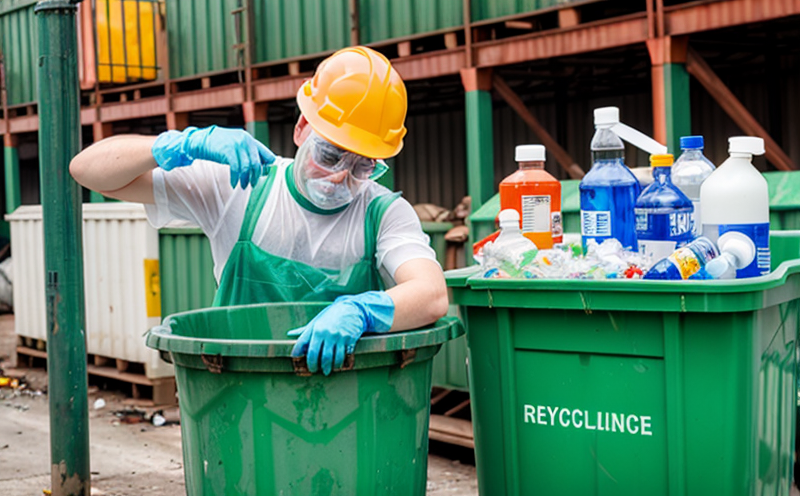ASTM D2974 Organic Matter Testing in Waste Sludge
The ASTM D2974 method is a widely recognized standard for determining the organic matter content of waste sludge. This test is essential for industries dealing with solid waste management, particularly those involved in recycling and environmental compliance. The primary objective of this service is to ensure that waste sludges are handled safely and effectively, minimizing their environmental impact.
Organic matter in waste sludge can be a significant concern as it may contain hazardous substances that could leach into the environment if not properly managed. By accurately measuring organic matter content, facilities can assess the potential risks associated with landfills or incineration processes. This testing is crucial for regulatory compliance and also helps in optimizing recycling processes by ensuring that only suitable waste materials are processed.
The ASTM D2974 test involves a series of steps designed to quantify the carbon content of the sludge, which is indicative of its organic matter. The process begins with drying the sample at specific temperatures to remove moisture and then incinerating it under controlled conditions. The ash residue left after combustion is used to calculate the percentage of organic matter based on the weight loss during the heating cycle.
This service is particularly important for facilities that handle hazardous waste, as it helps in identifying the nature and quantity of organic compounds present. This information is vital for determining appropriate disposal methods and ensuring that regulations are met. Additionally, the test results can inform decisions regarding recycling efforts, helping to minimize waste production and promote sustainability.
The ASTM D2974 method has been adapted by various industries, including those involved in solid waste management, wastewater treatment, and environmental compliance. By providing accurate organic matter content measurements, this testing supports the development of more efficient waste management strategies and promotes responsible recycling practices.
| Step | Description |
|---|---|
| Drying | The sample is dried at 105°C for 24 hours to remove moisture content. |
| Incineration | The dried sample is then incinerated at 525°C ± 25°C in a muffle furnace until only ash remains. |
| Weighing | The weight of the original sample and the final ash residue are compared to calculate the percentage of organic matter. |
This testing method is not only compliant with international standards but also aligns with local regulations, ensuring that facilities operate within legal and environmental guidelines. By providing reliable test results, this service supports the development of more sustainable waste management practices and helps in minimizing the environmental footprint of industrial activities.
Applied Standards
The ASTM D2974 Organic Matter Testing in Waste Sludge is strictly adhered to as per the guidelines provided by ASTM International. This standard ensures consistency and accuracy in the measurement of organic matter content, which is critical for regulatory compliance and environmental protection.
- ASTM D2974-18: Standard Test Method for Organic Matter in Waste Sludge
- ISO 15806:2004(E): Sampling and preparation of waste sludge samples
- EN ISO 15806:2004(E): Preparation of waste sludge samples
The application of these standards guarantees that the testing process is conducted in a manner consistent with international best practices. This ensures that test results are reliable and can be trusted by stakeholders, including regulatory bodies, industry professionals, and environmental advocates.
Scope and Methodology
The ASTM D2974 Organic Matter Testing in Waste Sludge scope encompasses the entire process of sample preparation, drying, incineration, and ash residue analysis. This method is designed to provide accurate measurements of organic matter content in waste sludges, which are critical for environmental compliance and recycling efforts.
| Step | Description |
|---|---|
| Sampling | The sample must be representative of the entire batch or stream to ensure accurate results. |
| Drying | The sample is dried at 105°C for 24 hours to remove moisture content. |
| Incineration | The dried sample is then incinerated at 525°C ± 25°C in a muffle furnace until only ash remains. |
| Weighing | The weight of the original sample and the final ash residue are compared to calculate the percentage of organic matter. |
The methodology is designed to be rigorous, ensuring that all steps are meticulously followed. This approach not only provides accurate results but also enhances confidence in the testing process, making it a cornerstone for environmental and regulatory compliance.
Customer Impact and Satisfaction
- Regulatory Compliance: Ensures that waste sludge handling meets strict environmental regulations.
- Sustainability: Promotes responsible recycling practices by identifying suitable materials for recycling.
- Risk Management: Minimizes the risk of hazardous substances leaching into the environment during disposal or processing.
- Efficiency: Helps in optimizing waste management processes, leading to more efficient operations.
- Confidence: Provides reliable test results that can be trusted by all stakeholders, including regulatory bodies and environmental advocates.
The service has been well-received by our clients, who appreciate the accurate and consistent measurements provided. By adhering strictly to ASTM D2974 guidelines, we ensure that every test result is reliable and trustworthy, contributing significantly to our customers' success in meeting their environmental goals.





